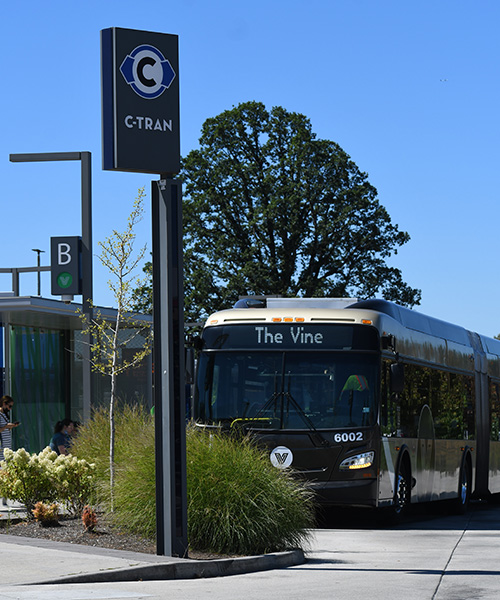Bus rapid transit, or BRT, uses a combination of ingredients to create more efficient and reliable transit service. Those can include larger buses, separate bus lanes at major intersections to bypass traffic congestion, specialized signals that give buses priority, station improvements, more attractive passenger facilities or other features. Not every BRT system looks the same. Different projects can use different elements depending on the needs or character of the community it serves. What makes sense for one corridor might not make sense for another.
BRT on Fourth Plain, Mill Plain
In 2017, C-TRAN launched the region’s first BRT system, The Vine, on Vancouver’s Fourth Plain corridor. The Vine uses 60-foot articulated buses, improved stations, traffic signal priority, level boarding platforms and other features to move passengers more efficiently and reliably on C-TRAN’s busiest corridor. The Vine had an immediate impact: Within the first year of operation, transit ridership on the Fourth Plain corridor jumped by 45 percent. Travel times and operating costs dropped. Since The Vine opened, there have been more than 2,000 housing units added within a half-mile of Fourth Plain, and roughly $250 million in development value.
In 2023, C-TRAN launched the second segment of The Vine, serving Vancouver's Mill Plain corridor. The Vine on Mill Plain builds on an already successful BRT system with a proven track record in Clark County.
BRT is more efficient
BRT borrows some of the features of light rail, but has the added flexibility of running on streets without needing a dedicated, fixed guideway. BRT buses are often longer and articulated with two or three doors on one or both sides, depending on the system. The buses are also built with low-floor entry to accommodate quick loading and unloading of passengers – including those using wheelchairs or with bikes. BRT stations are designed to enhance safety and security for riders and are typically open and well lit. Each BRT station is recognizable by its unique design, and carries the BRT system brand or identity. Some BRT buses are diesel-electric hybrids – including those on The Vine – and can reduce carbon emissions compared to regular diesel buses.
BRT can accommodate more riders by using larger vehicles and greater frequency. The Vine on Fourth Plain operates on a 12-minute frequency during peak times, and has benefited from special queue jump signals at two locations on the Fourth Plain corridor to reduce travel times – even while moving more passengers. The Vine on Mill Plain uses similar features, including queue jump signals on that corridor as well.
Paying fares on BRT
Rather than paying as you board the bus, BRT fares can be paid in advance at the platform. Passengers can use ticket vending machines to pay their fares before the bus arrives, then board the vehicle through multiple doors. On The Vine, passengers can also tap their Hop cards at either door as they board. Many BRT systems can complete their stops in 15 seconds or less. A standard bus loading several passengers, each paying a fare as they board, can take several minutes.
Where else is BRT operating?
In addition to The Vine, other BRT systems are operating in numerous cities around the U.S. and the world. In the Northwest, King County Metro’s RapidRide serves the Seattle area. Community Transit in Snohomish County operates two lines of its Swift BRT system. In Oregon, Lane Transit District’s BRT network known as EmX serves the Eugene-Springfield area.
Coming soon: Highway 99, Fourth Plain extension
C-TRAN is currently planning additional corridors for The Vine: Highway 99, operating between the Vancouver Waterfront and Salmon Creek/WSU Vancouver; and the Fourth Plain extension, serving east Fourth Plain and 162nd/164th Avenue. Both lines are projected to open in 2027.
